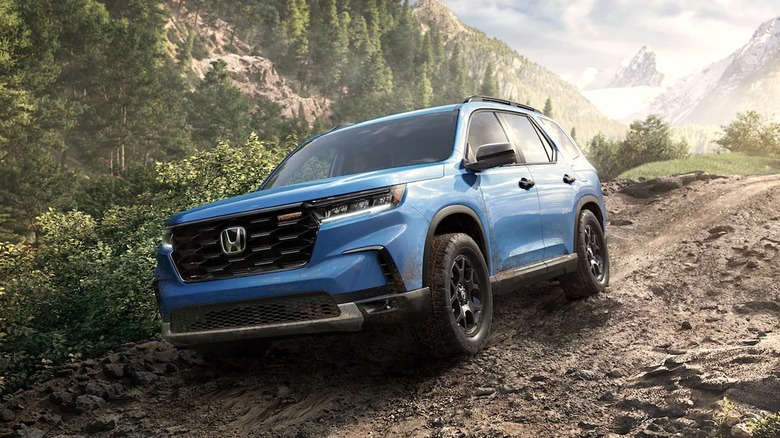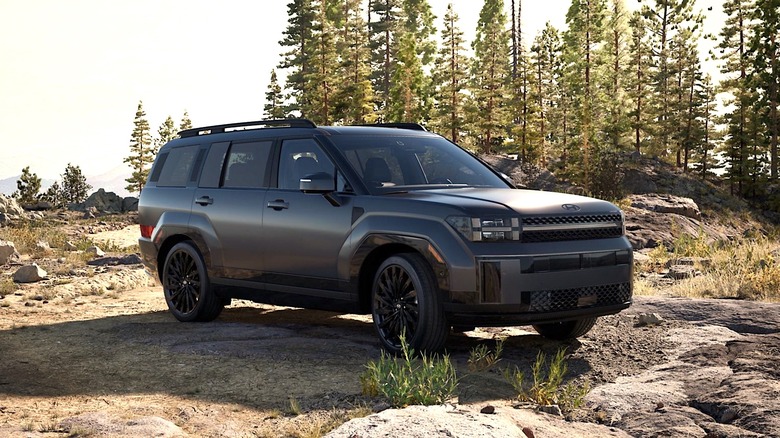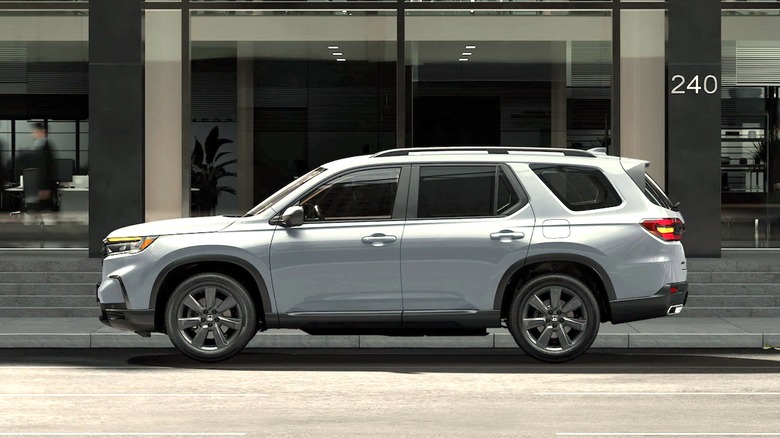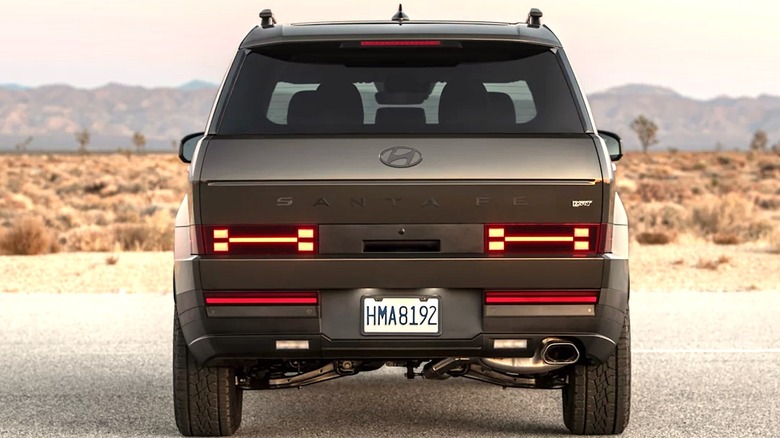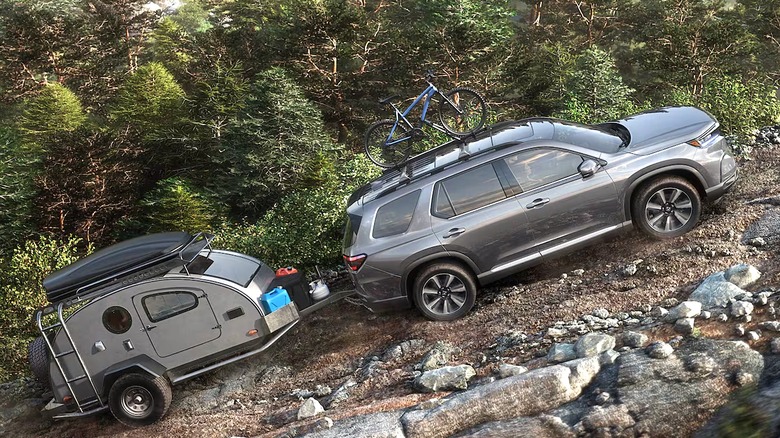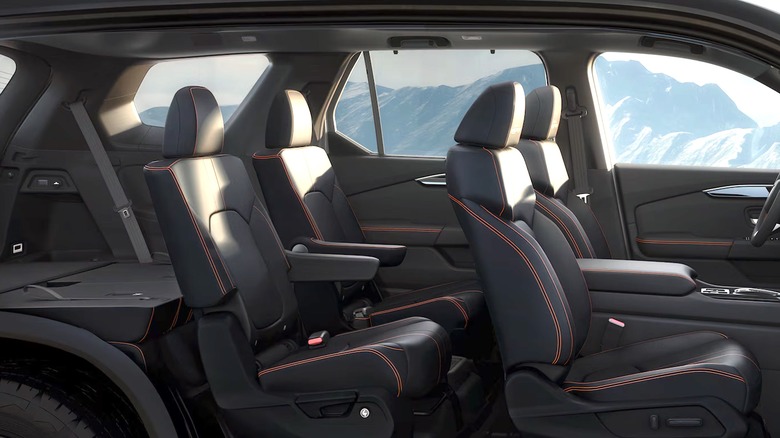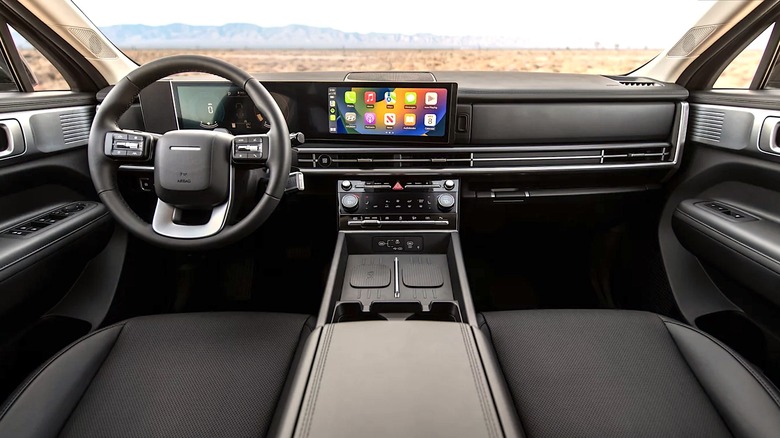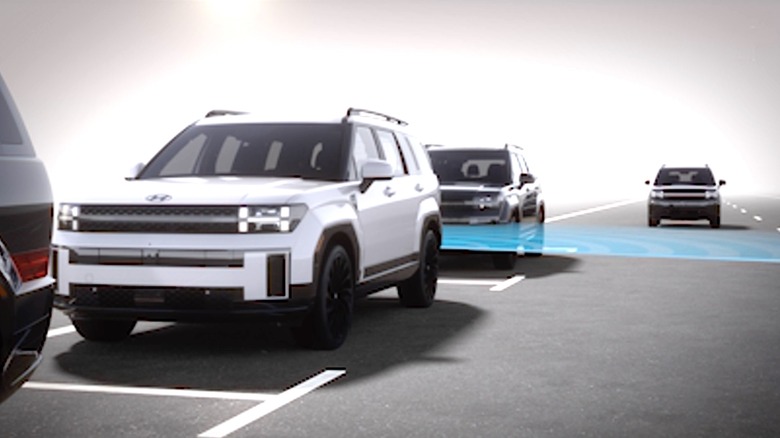Honda Pilot Vs. Hyundai Santa Fe: How Do These Popular SUVs Compare?
If you've bought a new car or even considered doing so in the past few years, you probably looked at some sort of sport utility vehicle. That style has, after all, ranked among the most popular in the U.S. and beyond for many years running. And with SUVs hitting the road from virtually every major automaker, there are more to choose from today than at any point in automotive history.
Even with so many options, price will likely play a major role in any potential buyer's decision making process, so SUVs from luxury automakers like Porsche, Audi, and BMW may be out of the question. If you've been shopping for an SUV with budget guiding the way, you've no doubt considered a build from Asian automakers like Honda and Hyundai. Both have multiple models in their respective lineups, ranging from compact builds to full-size. But if you're looking to get some bang for your SUV buck, their middle-of-the-road crossover-styled offerings may be your best play.
Among them are the Honda Pilot and the Hyundai Santa Fe, and if you've glanced at either, you know they boast a range of similarities that might make it difficult to decide which best suits your needs. There are, however, some notable differences that could break any stalemate. Here's a head-to-head look at the Honda Pilot and Hyundai Santa Fe.
What is the 2025 Hyundai Santa Fe?
Hyundai introduced the Santa Fe into its SUV lineup for the 2000 model year. In the more than two decades since, the Santa Fe has become one of the more prominent Hyundais, combining many of the best features of a full-size SUV and a full-size sedan. Given its enduring popularity, the Santa Fe will no doubt be a fixture in the Hyundai stable for many years to come, with some North American buyers perhaps being swayed by the fact that the Santa Fe is manufactured in the United States.
In the 2025 Santa Fe, Hyundai has continued to build on the rather dramatic redesign seen in the SlashGear-approved 2024 Santa Fe, fine-tuning its boxier, but undeniably tougher lines to give it a trail-ready feel. It is, of course, also well-suited to traversing the suburban landscapes of the world, making the mid-size SUV appealing to any family that regularly ventures out into the wilds for the weekend.
Versatility aside, one of the most appealing features of the Hyundai Santa Fe has long-been its price, with the South Korean manufacturer offering the base model for just $34,200. So if sticker price is the primary deciding factor in your SUV hunt, the Santa Fe is well worth a look.
What is the 2025 Honda Pilot?
Honda added the mid-size Pilot to its SUV line a few years after Hyundai released the Santa Fe. When the first Pilots took to the road in 2003, they build almost immediately served as stiff competition to not just the Santa Fe, but every other mid-size SUV on the market. The Pilot continues to be a solid seller for Honda, and is not likely to leave the Japanese company's celebrated lineup anytime in the foreseeable future.
In almost direct contrast to the Santa Fe, however, the made-in-North-America Honda Pilot hit the market fronting a decidedly boxier look, with the company's design team smoothing out and rounding its lines over the course of its production run. In fact, one could argue the 2025 Pilot's look is almost futuristic in comparison to many of its predecessors, though the roomy SUV has maintained a rugged overall appearance that makes it a good fit for city driving as well as a little light off-road duty.
There are plenty of appealing features in the Honda Pilot. However, the sticker price might test the wills of some potential buyers, with the base model Pilot starting at $40,200.
Warranty
Now that we've covered some of the basic facts concerning the Honda Pilot and the Hyundai Santa Fe, it's time to dig deeper. Let's start with what sort of manufacturer's warranty will cover the vehicle you select. The good news is that both Honda and Hyundai are well-regarded for reliability, so you may avoid frequent repair bills. Even better is that each company covers its vehicles with a solid warranty.
The Pilot is covered by a three-year or 36,000-mile limited warranty and five-year or 60,000-mile powertrain limited warranty, just like every other new Honda. That sort of coverage should ease the potential financial burden of breakdowns that might occur during the coverage period. Hondas made after 2014 also qualify for Honda's 24-hour roadside assistance coverage in the three-year or 36,000-mile period, which is not an entirely free service, but could be a nice add-on should you lock your keys in the car or if your battery needs a jump.
As for Hyundai, well, the manufacturer's new-car warranty coverage ranks among the best in the automotive industry, a fact the company proudly touts in ad campaigns. Hyundai's coverage dramatically eclipses that of Honda via a basic five-year or 50,000-mile new vehicle limited warranty and a 10-year or 100,000-mile powertrain warranty. Hyundai also offers five years of 24-hour roadside assistance with no mileage cap, and up to three years of complimentary maintenance, covering everything from oil changes to tire rotation.
Engine power
A vehicle's engine power and off-road capabilities will affect both how and where you choose to drive it. Though the Hyundai Santa Fe chalked up wins in overall price and warranty coverage, the Honda Pilot holds an edge in the power category.
The Pilot's 3.5-liter V6 engine can produce an impressive 285 horsepower, which should make it easier for you to tackle hard-to-reach and elevated locales. It will also be enough to let you tow up to 5,000 pounds of extra weight, roughly equal to a 24-foot camper or a pair of off-road-ready side-by-side vehicles. Honda has also equipped the Pilot with a specially designed suspension to make it easier to navigate off-road terrain, and if you want to improve the vehicle's off-road credentials, all-wheel drive and all-terrain tires can be added for an additional fee.
Yes, you can add AWD and off-road tires to the base model Hyundai Santa Fe for a few extra bucks as well, and such features will no doubt come in handy if you're looking to take the vehicle into the wilds. The automaker's optional HTRAC AWD could also prove a necessity if you're looking to haul a trailer off the road with you, as it boosts the Santa Fe's towing capacity from 3,500 pounds up to 4,500 pounds. At 277 horsepower, the Santa Fe's 2.5-liter turbocharged four-cylinder engine isn't exactly lacking in power. But if power is your primary play, the Pilot is packing a little more oomph.
Vehicle interiors
If you're not looking to take your SUV off the beaten path, you might be more concerned with how much space your passengers have when sitting side by side than how many side-by-sides you can pull. Interior size particularly matters to buyers with growing families, or those who find themselves regularly ferrying their kids and their kids' besties from one playdate to another.
Interior inches is another category in which the Honda Pilot bests the Hyundai Santa Fe. We should, however, note that, according to TrueCar.com, the Santa Fe actually offers a little more headroom than the Pilot, with 41.1 inches in the front seats and 40.6 in the rear seats for the Hyundai, versus 40.5 and 40.2 for the Honda. The Santa Fe offers more front-seat legroom as well, giving driver and co-pilot 44.4 inches to the Pilot's 41.
Legroom advantage aside, the Pilot's bucket seats are roomier, offering about a 2-inch width advantage in the hip and shoulder areas. And those width advantages carry over to the Pilot's second- and third-row seats, which are about 3 inches to almost 6 inches wider, respectively, than those in the Santa Fe. That width advantage likely accounts for the Pilot's eight-passenger seating capability, with the Santa Fe capping out at seven. With an almost-10-inch advantage in length (199.9 inches to 190.2), the Pilot also holds roughly the same advantage in cargo space over the Santa Fe.
Infotainment and tech features
Infotainment packages have become big selling points for every vehicle on the road, as car owners still want to feel connected to the world beyond when they're behind the wheel. And both the Honda Pilot and Hyundai Santa Fe boast solid offerings on the connectivity and entertainment fronts.
For many, infotainment conversations essentially begin and end with the size of a vehicle's LED touch display screen. If you count yourself in that group of drivers, the Santa Fe may be the ride for you, as its 12.3-inch display is more than three inches bigger than the Pilot's 9-inch touch screen. And we have to admit that the Santa Fe's screen being fully integrated into the driver-side dashboard display is a legit chef's kiss sort of design touch.
In terms of functionality, both infotainment packages are relatively similar, with each offering Bluetooth connectivity for both Apple and Android devices, making it easy for drivers to talk, text, and play music from their mobile device, as well as use any navigation apps they like. One distinct advantage the Pilot has over the Santa Fe is the ability to turn the infotainment center into a Wi-Fi hotspot, though for now that is only an option for folks with an AT&T mobile plan. Both the Pilot and Santa Fe are also equipped with dual wireless charging stations in their front console, though some driver's may prefer the latter's open and easily accessible design, as pictured above.
Road-safety suites
Safety will surely play a significant role in any decision concerning your new SUV. Both Honda Pilot and Hyundai Santa Fe are equipped with significant safety packages fronting tech-y features that use cameras and sensors to keep you safe on the road.
Every trim level of the Pilot comes with the Honda Sensing safety suite. That comprehensive driver-assistance package offers everything from a collision-mitigation braking system and road-departure mitigation to adaptive cruise control and lane-centering assistance. Sensing even has a traffic sign identification system that displays the signs in the dashboard of Pilots equipped with Head-Up Display. The Pilot also boasts an Advanced Compatibility Engineering body design that helps redistribute crash energy in a head-on collision, which no doubt helped the vehicle earn a five-star safety rating from the National Highway Traffic Safety Administration.
As of this writing, the '25 Santa Fe has not been rated by the NHTSA. However, the vehicle boasts some intriguing driver-assistance safety features of its own, including ones designed to ensure you keep a safe distance from vehicles ahead of you and stay in your own lane on the freeway. It also offers blind-spot detection and collision warnings, a driver alert system in case your wandering mind leads to a drifting car, and even a Safe Exit Assist function that prevents you from stepping into traffic when you exit the vehicle. That all translates to drivers feeling safe no matter which of these vehicles they choose.
